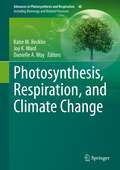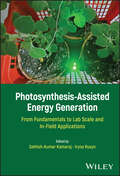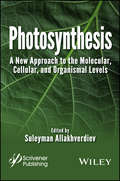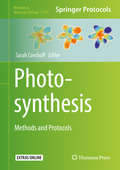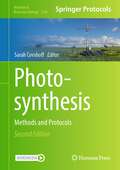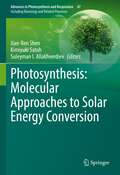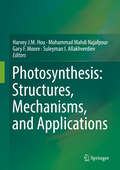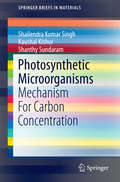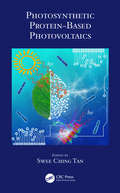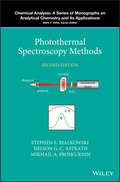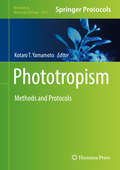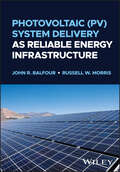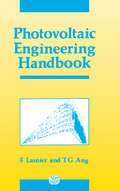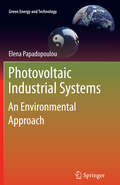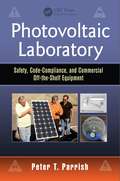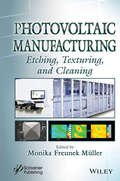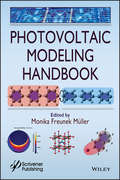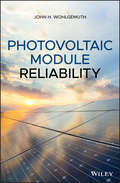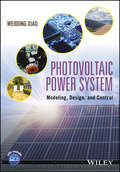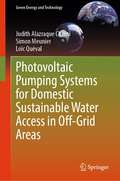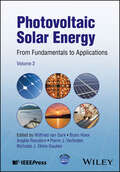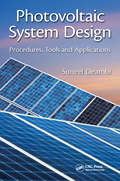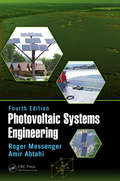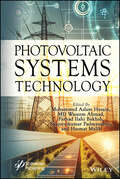- Table View
- List View
Photosynthesis, Respiration, and Climate Change (Advances in Photosynthesis and Respiration #48)
by Katie M. Becklin Joy K. Ward Danielle A. WayChanges in atmospheric carbon dioxide concentrations and global climate conditions have altered photosynthesis and plant respiration across both geologic and contemporary time scales. Understanding climate change effects on plant carbon dynamics is critical for predicting plant responses to future growing conditions. Furthermore, demand for biofuel, fibre and food production is rapidly increasing with the ever-expanding global human population, and our ability to meet these demands is exacerbated by climate change.This volume integrates physiological, ecological, and evolutionary perspectives on photosynthesis and respiration responses to climate change. We explore this topic in the context of modeling plant responses to climate, including physiological mechanisms that constrain carbon assimilation and the potential for plants to acclimate to rising carbon dioxide concentration, warming temperatures and drought. Additional chapters contrast climate change responses in natural and agricultural ecosystems, where differences in climate sensitivity between different photosynthetic pathways can influence community and ecosystem processes. Evolutionary studies over past and current time scales provide further insight into evolutionary changes in photosynthetic traits, the emergence of novel plant strategies, and the potential for rapid evolutionary responses to future climate conditions. Finally, we discuss novel approaches to engineering photosynthesis and photorespiration to improve plant productivity for the future.The overall goals for this volume are to highlight recent advances in photosynthesis and respiration research, and to identify key challenges to understanding and scaling plant physiological responses to climate change. The integrated perspectives and broad scope of research make this volume an excellent resource for both students and researchers in many areas of plant science, including plant physiology, ecology, evolution, climate change, and biotechnology. For this volume, 37 experts contributed chapters that span modeling, empirical, and applied research on photosynthesis and respiration responses to climate change. Authors represent the following seven countries: Australia (6); Canada (9), England (5), Germany (2), Spain (3), and the United States (12).
Photosynthesis-Assisted Energy Generation: From Fundamentals to Lab Scale and In-Field Applications
by Sathish-Kumar Kamaraj Iryna RusynPhotosynthesis-Assisted Energy Generation Describes the mechanisms of and potential for using microorganisms and plants as renewable power resources Bridging the knowledge gap between the fundamentals and the technological advances in biological photosynthesis-assisted energy generation, Photosynthesis-Assisted Energy Generation explores the various diverse light-harvesting biological systems for electricity generation and explains the fundamentals and applications from lab-scale to in-field. The text discusses the fundamentals of electron transfer mechanisms in photosynthetic systems, basic principles of bioelectricity generation, and materials involved in the construction of fuel cells, including not only the impact of higher plants, but also anoxygenic and oxygenic photosynthetic bacteria and microalgae on the performance of photosynthesis-assisted power generation systems. A timely resource, the text features case studies on emerging topics such as mosses in power generation on green roofs and photo-bioelectrochemical fuel cells for antibiotics and dyes removal, along with discussion of sustainability issues when scaling up bio-photo-electrochemical systems. Edited by two highly qualified and accomplished academics with significant research experience in the field, Photosynthesis-Assisted Energy Generation includes information on: Role of functional materials involved in photosynthesis-assisted power generation and non-noble electrocatalysts as air cathodes in biocells Electricity generation and intensified synthesis of nutrients by plant-based biofuel cells using duckweeds as biocatalysts Algae-based microbial fuel cells, photosynthetic bacteria-based microbial fuel cells, and bryophyte microbial fuel cell systems Progress and recent trends of application of low-energy consuming devices and IoT based on photosynthesis-assisted power generation Plant-based microbial fuel cells for bioremediation, biosensing, and plant health monitoring With full coverage of an attractive renewable energy generation system, Photosynthesis-Assisted Energy Generation is an essential resource on the subject for researchers and scientists interested in alternative renewable energetics and photosynthesis-assisted energy generation processes utilizing microorganisms, algae, plants, and other bioinspired materials.
Photosynthesis: A New Approach to the Molecular, Cellular, and Organismal Levels
by Suleyman I. AllakhverdievPhotosynthesis is one of the most important processes that affects all life on Earth, and, even now in the twenty-first century, it is still being studied and tested by scientists, chemists, and botanists. Regardless of politics or opinion, climate change is one of the most polarizing and important, potentially dangerous, issues facing the future of our planet, and a better understanding of photosynthesis, and how it is changing with our global climate, could hold the answers to many scientific questions regarding this important phenomenon. This edited volume, written by some of the world's foremost authorities on photosynthesis, presents revolutionary new ideas and theories about photosynthesis, and how it can be viewed and studied at various levels within organisms. Focusing on the molecular, cellular, and organismic levels, the scientists who compiled this volume offer the student or scientist a new approach to an old subject. Looking through this new lens, we can continue to learn more about the natural world in which we live and our place in it. Valuable to the veteran scientist and student alike, this is a must-have volume for anyone who is researching, studying, or writing about photosynthesis. There are other volumes available that cover the subject, from textbooks to monographs, but this is the first time that a group of papers from this perspective has been gathered by an editor for publication. It is an important and enlightening work on a very important subject that is integral to life on Earth.
Photosynthesis: Methods and Protocols (Methods in Molecular Biology #1770)
by Sarah CovshoffThis user-friendly book provides a range of classical and modern techniques for the study of photosynthesis in a manner accessible to a broad spectrum of researchers. Broken into four sections, it explores the measurement of physiological photosynthetic parameters, quantifying photosynthetic enzyme abundance and catalytic activity, visualizing cellular and sub-cellular phenotypes, and photosynthesis-inspired energy generation. Written for the highly successful Methods in Molecular Biology series, chapters include introductions to their respective topics, lists of the necessary materials and reagents, step-by-step laboratory protocols, and tips on troubleshooting and avoiding known pitfalls. Authoritative and practical, Photosynthesis: Methods and Protocols aims to aid scientists working toward exciting developments in the understanding and application of photosynthesis.
Photosynthesis: Methods and Protocols (Methods in Molecular Biology #2790)
by Sarah CovshoffThis fully updated edition explores fundamental protocols for the study of photosynthesis in a manner accessible to a broad spectrum of researchers. Featuring protocols to examine light response curves and gas exchange measurements for a variety of samples, the book includes new protocols on photosynthesis in the adaxial and abaxial sides of a leaf, non-foliar organs, and aquatic systems. Protocols and best practice for eddy covariance, thermal, spectral, and hyperspectral imaging and data analysis, as well as stable isotope labeling and quantification of photosynthetic metabolites, are introduced alongside fresh insights on many more topics. Written for the highly successful Methods in Molecular Biology series, chapters include introductions to their respective topics, lists of the necessary materials and reagents, step-by-step and readily reproducible laboratory protocols, and tips on troubleshooting and avoiding known pitfalls. Authoritative and up-to-date, Photosynthesis: Methods and Protocols, Second Edition provides an ideal guide to the improved technologies expanding our capabilities to study photosynthesis today.
Photosynthesis: Molecular Approaches to Solar Energy Conversion (Advances in Photosynthesis and Respiration #47)
by Suleyman I. Allakhverdiev Kimiyuki Satoh Jian-Ren ShenIn the modern world, to meet increasing energy demands we need to develop new technologies allowing us to use eco-friendly carbon-neutral energy sources. Solar energy as the most promising renewable source could be the way to solve that problem, but it is variable depending on day time and season. From this side, the understanding of photosynthesis process could be of significant help for us to develop effective strategies of solar energy capturing, conversion, and storage. Plants, algae, and cyanobacteria perform photosynthesis, annually producing around 100 billion tons of dry biomass. Presently, the detailed studies of photosynthetic system structure make functional investigations of the photosynthetic process available, allowing scientists to construct artificial systems for solar energy transduction. This book summarizes exciting achievements in understanding of photosynthetic structures and mechanisms of this process made by world leaders in photosynthesis field, and contains information about modern ideas in development of revolutionary new technologies of energy conversion. Organized according to the natural sequence of events occurring during photosynthesis, the book includes information of both photosynthetic structures and mechanisms and its applications in bioenergetics issues.
Photosynthesis: Structures, Mechanisms, and Applications
by Suleyman I. Allakhverdiev Harvey J. M. Hou Mohammad Mahdi Najafpour Gary F. MooreTo address the environmental, socioeconomic, and geopolitical issues associated with increasing global human energy consumption, technologies for utilizing renewable carbon-free or carbon-neutral energy sources must be identified and developed. Among renewable sources, solar energy is quite promising as it alone is sufficient to meet global human demands well into the foreseeable future. However, it is diffuse and diurnal. Thus effective strategies must be developed for its capture, conversion and storage. In this context, photosynthesis provides a paradigm for large-scale deployment. Photosynthesis occurs in plants, algae, and cyanobacteria and has evolved over 3 billion years. The process of photosynthesis currently produces more than 100 billion tons of dry biomass annually, which equates to a global energy storage rate of ~100 TW. Recently, detailed structural information on the natural photosynthetic systems has been acquired at the molecular level, providing a foundation for comprehensive functional studies of the photosynthetic process. Likewise, sophisticated spectroscopic techniques have revealed important mechanistic details. Such accomplishments have made it possible for scientists and engineers to construct artificial systems for solar energy transduction that are inspired by their biological counterparts. The book contains articles written by experts and world leaders in their respective fields and summarizes the exciting breakthroughs toward understanding the structures and mechanisms of the photosynthetic apparatus as well as efforts toward developing revolutionary new energy conversion technologies. The topics/chapters will be organized in terms of the natural sequence of events occurring in the process of photosynthesis, while keeping a higher-order organization of structure and mechanism as well as the notion that biology can inspire human technologies. For example, the topic of light harvesting, will be followed by charge separation at reaction centers, followed by charge stabilization, followed by chemical reactions, followed by protection mechanisms, followed by other more specialized topics and finally ending with artificial systems and looking forward. As shown in the table of contents (TOC), the book includes and integrates topics on the structures and mechanisms of photosynthesis, and provides relevant information on applications to bioenergy and solar energy transduction.
Photosynthetic Microorganisms
by Shailendra Kumar Singh Shanthy Sundaram Kaushal KishorThis book provides a cohesive overview of carbon concentrating mechanism (CCM) of photosynthetic microorganisms such as cyanobacteria and microalgae. This unique mechanism is by far the most spectacular physiological process in algal growth and productivity. Due to this fact, the study of CCM has captivated phycologists, algal molecular and cellular biologists, botanists, agriculturalists, crop growers, and most recently algal biofuel researchers, around the world. In the brief, the authors draw a contextual in-depth overview, on the basis of the latest findings, to develop an account of the core concepts regarding state-of-the-art of CCM. Subsequent chapters use this account to explore carbon concentrating mechanism of cyanobacteria and microalgae. They highlight the concise summaries of cutting-edge research and integrated industrial applications of photosynthetic microorganism based CO2 mitigation system, across a wide spectrum of energy and environment. The brief also presents sustainable perspectives of carbon concentrating mechanism in the context of current global energy and environmental challenges.
Photosynthetic Protein-Based Photovoltaics
by Swee Ching TanEver since the discovery of the photoelectric effect, researchers have been trying to improve the efficiency of converting sunlight into electricity through photovoltaic devices. Photosynthetic organisms provide clues for harvesting sunlight and storing the energy in chemical forms. This book offers a concise overview of the fundamental concepts of photosynthesis and the emerging photovoltaic technologies, casting light on the symbiotic relation between these spheres of science. Although there are many books about the fundamentals of photosynthesis and the various aspects of the photosynthetic processes, this is the first volume to focus on the prospects of studying the photosynthetic proteins, understanding and applying their properties to design prospective solar energy conversion devices that are sustainable and efficient. All in all, the book aims to bring together the present know-how on organic photovoltaics and dye-sensitized solar cells with that of the emerging bio-photovoltaics and the underlying physics of photosynthesis to foster a more eclectic research that would converge towards a sustainable energy technology for the future. The book mainly serves as a bridge to connect biochemists, who study photosynthetic proteins, and physicists and engineers who design and develop photovoltaic devices. Scientists, engineers and students in the fields of photosynthetic research and solar energy research can use this book as a ready reference. Key selling features: Covers both methods and bio-based materials needed to build bio-based photovoltaics Focuses on both techniques and applications Summarizes the advantages and limitations of various techniques Contributors from multiple disciplines integrate the knowledge of photosynthetic proteins and the physics/engineering of photovoltaic devices. Includes adaptive designs and techniques used in other types of solar cells to for the design of protein-based PVs
Photothermal Spectroscopy Methods (Chemical Analysis: A Series of Monographs on Analytical Chemistry and Its Applications #177)
by Stephen E. Bialkowski Nelson G.C. Astrath Mikhail A. ProskurninCovers the advantages of using photothermal spectroscopy over conventional absorption spectroscopy, including facilitating extremely sensitive measurements and non-destructive analysis This unique guide to the application and theory of photothermal spectroscopy has been newly revised and updated to include new methods and applications and expands on applications to chemical analysis and material science. The book covers the subject from the ground up, lists all practical considerations needed to obtain accurate results, and provides a working knowledge of the various methods in use. Photothermal Spectroscopy Methods, Second Edition includes the latest methods of solid state and materials analysis, and describes new chemical analysis procedures and apparatuses in the analytical chemistry sections. It offers a detailed look at the optics, physical principles of heat transfer, and signal analysis. Information in the temperature change and optical elements in homogeneous samples and photothermal spectroscopy in homogeneous samples has been updated with a better description of diffraction effects and calculations. Chapters on analytical measurement and data processing and analytical applications are also updated and include new information on modern applications and photothermal microscopy. Finally, the Photothermal Spectroscopy of Heterogeneous Sample chapter has been expanded to incorporate new methods for materials analysis. New edition updates and expands on applications to chemical analysis and materials science, including new methods of solid state and materials analysis Includes new chemical analysis procedures and apparatuses Provides an unmatched resource that develops a consistent mathematical basis for signal description, consolidates previous theories, and provides invaluable insight into laser technology Photothermal Spectroscopy Methods, Second Edition will appeal to researchers from both academia and industry (graduate students, postdocs, research scientists, and professors) in the general field of analytical chemistry, optics, and materials science, and researchers and engineers at scientific instrument developers in fields related to photonics and spectroscopy.
Phototropism: Methods and Protocols (Methods in Molecular Biology #1924)
by Kotaro T. YamamotoThis book aims to promote studies on the entire spectrum of phototropic phenomena in higher and lower plants and fungi. Chapters detail phototropism in many plant species induced by far-red, red, blue and UV lights. They also include methods for auxin biology and analysis of cytoskeleton and phototropin. In addition, the use of grafting, spaceflight experiment and image analysis in tropism study is provided. Written in the highly successful Methods in Molecular Biology series format, chapters include introductions to their respective topics, lists of the necessary materials and reagents, step-by-step, readily reproducible laboratory protocols, and tips on troubleshooting and avoiding known pitfalls. Authoritative and cutting-edge, Phototropism: Methods and Protocols aims to ensure successful results in the further study of this vital field.
Photovoltaic (PV) System Delivery as Reliable Energy Infrastructure
by John R. Balfour Russell W. MorrisPHOTOVOLTAIC (PV) SYSTEM DELIVERY AS RELIABLE ENERGY INFRASTRUCTURE A practical guide to improving photovoltaic power plant lifecycle performance and output Photovoltaic (PV) System Delivery as Reliable Energy Infrastructure introduces a Preemptive Analytical Maintenance (PAM) for photovoltaic systems engineering, and the Repowering™ planning approach, as a structured integrated system delivery process. A team of veteran photovoltaics professionals delivers a robust discussion of the lessons learned from mature industries—including PV, aerospace, utilities, rail, marine, and automotive—as applied to the photovoltaic industry. The book offers real-world “technical and fiscal” examples of the impact of photovoltaics to all stakeholders during the concept, specification, operations, maintenance, and Repowering™ phases. In each chapter, readers will learn to develop RAMS specifications, reliability data collection, and tasks while becoming familiar with the inherent benefits of how these affect the cost of design and development, maintenance, spares, and systems operation. The authors also explain when and how to consider and implement Repowering™, plant upgrades and the considerations from concept through retirement and disposal of the plant. Readers will also find: A thorough introduction to Preemptive Analytical Maintenance (PAM), including systems engineering, lifecycle planning, risk management, risk assessment, risk reduction, as compared to the historic utility models, An in-depth treatment of the modern photovoltaic industry, including economic factors and the present endlessly evolving state of technology, Constructive discussions and application of systems engineering, including RAMS and System Engineering practices and solutions, Extensive explorations and application of data collection, curation, and analysis for PV systems, including advanced sensor technologies. Perfect for all new through to experienced photovoltaic design and specification engineers, photovoltaic plant owners, operators, PV asset managers and all interested stakeholders. Photovoltaic (PV) System Delivery as Reliable Energy Infrastructure will also earn a place in the libraries of utilities, engineering, procurements, construction professionals and students.
Photovoltaic Engineering Handbook
by F LasnierThe Photovoltaic Engineering Handbook is the first book to look closely at the practical problems involved in evaluating and setting up a photovoltaic (PV) power system. The author's comprehensive knowledge of the subject provides a wealth of theoretical and practical insight into the different procedures and decisions that designers need to make. Unique in its coverage, the book presents technical information in a concise and simple way to enable engineers from a wide range of backgrounds to initiate, assess, analyze, and design a PV system. It is beneficial for energy planners making decisions on the most appropriate system for specific needs, PV applications engineers, and anyone confronting the practical difficulties of setting up a PV power system.
Photovoltaic Industrial Systems
by Elena PapadopoulouThis book investigates the existing situation of photovoltaic systems regarding environmental questions and energy efficiency in the European Industry, particularly the industrial units at the Greek area. A model of energy management based on economical, technical and administrative aspects is proposed in order to combine industrial uses of photovoltaics with environment protection.
Photovoltaic Laboratory: Safety, Code-Compliance, and Commercial Off-the-Shelf Equipment
by Peter T. ParrishPhotovoltaic Laboratory: Safety, Code-Compliance, and Commercial Off-the-Shelf Equipment is the only textbook that offers students the opportunity to design, build, test, and troubleshoot practical PV systems based on commercially available equipment. Complete with electrical schematics, layouts, and step-by-step installation instructions, this hands-on laboratory manual: Promotes "safety first" by covering working in extreme weather conditions, personal protective equipment, working at heights, electrical safety, and power tool safety Includes chapters on trade math, DC/AC electrical circuits, and assessing a property for a photovoltaic system (e.g., surveying the available space, shading, and solar harvest) Discusses aspects of mechanical and electric integration specific to different roof types, and characterizing a PV module under different levels of irradiation and ambient temperature Addresses the design, installation, and testing of off-grid PV systems with DC-only loads and with DC and AC loads, as well as 2.4 kw DC grid-tied PV systems with microinverters and string inverters Trains students on exactly the sort of equipment that they will encounter in the field, so they gain valuable experience and skills that translate directly to real-world applications Photovoltaic Laboratory: Safety, Code-Compliance, and Commercial Off-the-Shelf provides in-depth, project-driven instruction on everything from attaching brackets and flashing to modeling PV cells, modules, and arrays. This textbook is ideal preparation for those seeking a career in the PV industry—from system installers and designers to quality assurance and sales/marketing personnel.
Photovoltaic Manufacturing: Etching, Texturing, and Cleaning (Solar Cell Manufacturing)
by Monika Freunek MüllerThis is the first book on photovoltaic wet processing for silicon wafers, both mono- and multi-crystalline. The comprehensive book provides information to process, equipment, and device engineers and researchers in the solar manufacturing field. The authors of the chapters are world-class researchers and experts in their field of endeavor. The fundamentals of wet processing chemistry are introduced, covering etching, texturing, cleaning and metrology. New developments, innovative approaches, as well as current challenges are presented. A detailed discussion of black silicon is provided.
Photovoltaic Modeling Handbook
by Monika Freunek MüllerThis book provides the reader with a solid understanding of the fundamental modeling of photovoltaic devices. After the material independent limit of photovoltaic conversion, the readers are introduced to the most well-known theory of "classical" silicon modeling. Based on this, for each of the most important PV materials, their performance under different conditions is modeled. This book also covers different modeling approaches, from very fundamental theoretic investigations to applied numeric simulations based on experimental values. The book concludes wth a chapter on the influence of spectral variations. The information is supported by providing the names of simulation software and basic literature to the field. The information in the book gives the user specific application with a solid background in hand, to judge which materials could be appropriate as well as realistic expectations of the performance the devices could achieve.
Photovoltaic Module Reliability
by John H. WohlgemuthProvides practical guidance on the latest quality assurance and accelerated stress test methods for improved long-term performance prediction of PV modules This book has been written from a historical perspective to guide readers through how the PV industry learned what the failure and degradation modes of PV modules were, how accelerated tests were developed to cause the same failures and degradations in the laboratory, and then how these tests were used as tools to guide the design and fabrication of reliable and long-life modules. Photovoltaic Module Reliability starts with a brief history of photovoltaics, discussing some of the different types of materials and devices used for commercial solar cells. It then goes on to offer chapters on: Module Failure Modes; Development of Accelerated Stress Tests; Qualification Testing; and Failure Analysis Tools. Next, it examines the use of quality management systems to manufacture PV modules. Subsequent chapters cover the PVQAT Effort; the Conformity Assessment and IECRE; and Predicting PV Module Service Life. The book finishes with a look at what the future holds for PV. A comprehensive treatment of current photovoltaic (PV) technology reliability and necessary improvement to become a significant part of the electric utility supply system Well documented with experimental and practical cases throughout, enhancing relevance to both scientific community and industry Timely contribution to the harmonization of methodological aspects of PV reliability evaluation with test procedures implemented to certify PV module quality Written by a leading international authority in PV module reliability Photovoltaic Module Reliability is an excellent book for anyone interested in PV module reliability, including those working directly on PV module and system reliability and preparing to purchase modules for deployment.
Photovoltaic Power System: Modeling, Design, and Control
by Weidong XiaoPhotovoltaic Power System: Modelling, Design and Control is an essential reference with a practical approach to photovoltaic (PV) power system analysis and control. It systematically guides readers through PV system design, modelling, simulation, maximum power point tracking and control techniques making this invaluable resource to students and professionals progressing from different levels in PV power engineering. The development of this book follows the author's 15-year experience as an electrical engineer in the PV engineering sector and as an educator in academia. It provides the background knowledge of PV power system but will also inform research direction. Key features: Details modern converter topologies and a step-by-step modelling approach to simulate and control a complete PV power system. Introduces industrial standards, regulations, and electric codes for safety practice and research direction. Covers new classification of PV power systems in terms of the level of maximum power point tracking. Contains practical examples in designing grid-tied and standalone PV power systems. Matlab codes and Simulink models featured on a Wiley hosted book companion website.
Photovoltaic Pumping Systems for Domestic Sustainable Water Access in Off-Grid Areas (Green Energy and Technology)
by Judith Alazraque Cherni Simon Meunier Loïc QuévalThis book offers practical guidance for practitioner engineers, policymakers, and other decision-makers on how to implement solar photovoltaic water pumping systems to provide domestic clean water in off-grid regions of developing countries. By championing genuine multidisciplinary research and generating interdisciplinary results, this book develops models and approaches which indicate how it might be possible to overcome some of the limitations that technocratic approaches to renewable energy and water access pose to truly sustainable development.The book addresses technical challenges often found when promoting photovoltaic water pumping systems. It offers practical guidance to stakeholders on how to successfully select, install, and maintain photovoltaic water pumps to promote sustainable options for the poorest underserved areas/populations. A main novelty of this book is that, by using theoretical, as well as real/actual field-work data, and advanced modelling, it successfully connects energy systems engineering, environmental and geographical information and hydrology with population surveys which reveal local needs and conditions.The book is timely and important. More than 665 700 million worldwide still do not have access to improved drinking water sources; eight out of ten live in rural areas typically located either in off-grid territory, or where connection to nearby grid is too expensive or unfeasible. Unsafe water is responsible for 1.2 million deaths each year, mainly correlated with the diarrheal diseases generated from drinking water from unimproved water sources. Sustainable Development Goal 6 (clean water and sanitation) may be achieved only if water is accessible to everyone, available when needed and free from contamination.
Photovoltaic Solar Energy: From Fundamentals to Applications, Volume 2 (IEEE Press)
by Angèle Reinders Pierre Verlinden Wilfried Van Sark Bram Hoex Nicholas J. Ekins-DaukesPhotovoltaic Solar Energy Thoroughly updated overview of photovoltaic technology, from materials to modules and systems Volume 2 of Photovoltaic Solar Energy provides fundamental and contemporary knowledge about various photovoltaic technologies in the framework of material science, device physics of solar cells, chemistry for manufacturing, engineering of PV modules, and the design aspects of photovoltaic applications, with the aim of informing the reader about the basic knowledge of each aspect of photovoltaic technologies and applications in the context of the most recent advances in science and engineering. The text is written by leading specialists for each topic in a concise manner and includes the most recent references for deeper study. Moreover, the book gives insights into possible future developments in the field of photovoltaics. The book builds on the success of Volume 1 of Photovoltaic Solar Energy, which was published by Wiley in January 2017. As science and technology is progressing fast in some areas of photovoltaics, several topics needed to be readdressed. Volume 2 also covers some basic aspects of the subject that were not addressed in Volume 1. Sample topics covered in Photovoltaic Solar Energy include: Solar Irradiance ResourcesCrystalline Silicon Technologies (Cz Ingots, TOPCon, Heterojunction, Passivating contacts, Hydrogenation and Carrier Induced Degradation)Perovskite and Tandem solar cellsCharacterization and MeasurementsPV ModulesPV Systems and Applications (integration in buildings, agriculture, water, vehicles)Sustainability Providing comprehensive coverage of the subject, Photovoltaic Solar Energy is an essential resource for undergraduate and graduate students in science or engineering, young professionals in PV research or the PV industry, professors, teachers, and PV specialists who want to receive updated information. A scientific or engineering degree is a prerequisite.
Photovoltaic Sources
by Gianpaolo Vitale Maria Carmela Di PiazzaModeling of photovoltaic sources and their emulation by means of power electronic converters are challenging issues. The former is tied to the knowledge of the electrical behavior of the PV generator; the latter consists in its realization by a suitable power amplifier. This extensive introduction to the modeling of PV generators and their emulation by means of power electronic converters will aid in understanding and improving design and set up of new PV plants. The main benefit of reading Photovoltaic Sources is the ability to face the emulation of photovoltaic generators obtained by the design of a suitable equipment in which voltage and current are the same as in a real source. This is achieved according to the following steps: the source electrical behavior modeling, the power converter design, including its control, for the laboratory emulator. This approach allows the reader to cope with the creation of an indoor virtual photovoltaic plant, in which the environmental conditions can be imposed by the user, for testing real operation including maximum power point tracking, partial shading, control for the grid or load interfacing, etc. Photovoltaic Sources is intended to meet the demands of postgraduate level students, and should prove useful to professional engineers and researchers dealing with the problems associated with modeling and emulation of photovoltaic sources.
Photovoltaic System Design: Procedures, Tools and Applications
by Suneel DeambiIntroducing a Reliable Green Technology That Can Help Improve System Performance Solely centered on photovoltaic (PV) system sizing and the tools used for PV system analysis and design, Photovoltaic System Design: Procedures, Tools and Applications emphasizes the importance of using solar PV technologies for a number of end-use applications, and examines growing interest in solar PV-based projects on a global scale. Written for the system designer/project developer/manufacturer dedicated to correctly sizing a PV system, the book outlines various aspects of PV technology, applications, and programs. It describes key attributes, system design requirements, influence on climatic and site-specific parameters, utilization of simulation procedures, and expected performance. The author includes actual case studies for system designing procedures adopted by various companies and provides a framework for working through both direct and indirect variables under the actual system designing phase. A vital resource essential to your collection, this book: Touches upon the role of renewable energy technologies in a holistic energy scenario Makes a clear categorization of off-grid and on-grid PV applications and discusses advantages and limitations Considers the potential of solar radiation availability Introduces PV system sizing procedures via the modern use of simulation softwares Presents an analysis of actual PV power plant sites when designed via the use of simulation software Determines the weak links in a PV system Brings out the importance of capacity building initiatives vis-à-vis the available range of PV simulation software, tools, and procedures Photovoltaic System Design: Procedures, Tools and Applications provides a clear understanding of the issues that can affect the operation and smooth running of PV facilities and aids in determining photovoltaic system sizing procedures from a variety of end-use considerations. The book encompasses civil, mechanical, electrical, geotechnical, and power systems engineering and is useful to industry professionals involved in solar power plant design.
Photovoltaic Systems Engineering
by Roger A. Messenger Amir AbtahiThe primary purpose of PV Systems Engineering is to provide a comprehensive set of PV knowledge and understanding tools for the design, installation, commissioning, inspection, and operation of PV systems. During recent years in the United States, more PV capacity was installed than any other electrical generation source. In addition to practical system information, this new edition includes explanation of the basic physical principles upon which the technology is based and a consideration of the environmental and economic impact of the technology. The material covers all phases of PV systems from basic sunlight parameters to system commissioning and simulation, as well as economic and environmental impact of PV. With homework problems included in each chapter and numerous design examples of real systems, the book provides the reader with consistent opportunities to apply the information to real-world scenarios.
Photovoltaic Systems Technology
by Hasmat Malik P. Sanjeevikumar Farhad Ilahi Bakhsh Mohammed Aslam Husain Md Waseem AhmadPHOTOVOLTAIC SYSTEMS TECHNOLOGY Discover comprehensive insights into the latest advancements in solar PV technology, including power electronics, maximum power point tracking schemes, and forecasting techniques, with a focus on improving the performance of PV systems. A huge number of research articles and books have been published in the last two decades, covering different issues of PV efficiency, circuits, and systems for power processing and their related control. Books that have been published cover one or more topics but altogether fail to give a complete picture of the different aspects of PV systems. Photovoltaic Systems Technology aims to close the gap by providing a comprehensive review of techniques/practices that are dedicated to improving the performance of PV systems. The book is divided into three parts: the first part is dedicated to advancements in power electronic converters for PV systems; tools and techniques for maximum power point tracking of PV systems will be covered in the second part of the book; and the third part covers advancements in techniques for solar PV forecasting. The overall focus of the book is to highlight the advancements in modeling, design, performance under faulty conditions, forecasting, and application of solar photovoltaic (PV) systems using metaheuristic, evolutionary computation, machine learning, and AI approaches. It is intended for researchers and engineers aspiring to learn about the latest advancements in solar PV technology with emphasis on power electronics involved, maximum power point tracking (MPPT) schemes, and forecasting techniques.
